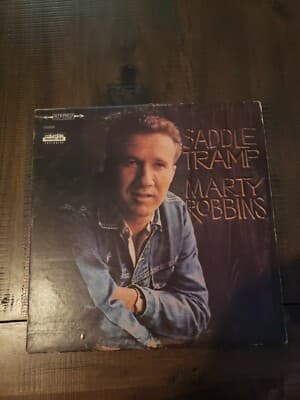
The Drifter’s Lonesome Path: A Timeless Tale of the American West
A haunting portrayal of the life of a drifter, forever wandering and searching. Ah, to be an old soul, sitting here with a cup of coffee as the sun dips below the horizon, and letting the memories flood back with the first few chords of a song. There are some tunes that are more than just melodies; they are entire stories, entire lifetimes told in three minutes. For many of us, the song “Saddle Tramp” by the incomparable Marty Robbins is one of those. It’s a piece of music that doesn’t just entertain; it transports you back to a time of wide-open spaces, dusty trails, and a certain kind of lonesome freedom that feels both romantic and profoundly sad.
Released as a track on the album More Gunfighter Ballads and Trail Songs in 1960, “Saddle Tramp” didn’t storm the charts as a standalone hit like its older brother, “El Paso.” Its journey was a quieter, more personal one, finding its audience through the rich, narrative tapestry of the album itself. The album, much like its predecessor, was a masterclass in Western storytelling, and this song was a crucial thread in that weave. It was a song for those who understood the quiet ache of solitude, a reflection on a life lived on the move, with no place to truly call home.
The story behind the song is a direct reflection of the character it portrays. A “saddle tramp” is a term for a person who wanders from place to place on horseback, often looking for odd jobs. Marty Robbins, with his deep love for the American West, captures this archetype with breathtaking clarity. The song is a first-person narrative, a stark, honest confession from a man who has no roots, no family, and no future beyond the next horizon. The lines paint a picture of a man who is “no good” in the eyes of others, but whose journey is a spiritual and emotional one. It’s the kind of song that makes you want to pull up a rocking chair, close your eyes, and listen to the world he describes—the creak of the saddle, the sigh of the wind, the endless, empty landscape.
The genius of Marty Robbins was his ability to make these historical figures and forgotten lifestyles feel intimately personal. He didn’t just sing about the West; he embodied it. His voice, a perfect blend of smoothness and weary authenticity, carries the weight of the character’s burdens. When he sings, “They call me a drifter, they say I’m no good,” it’s not just a lyric; it’s a lament from the soul. The meaning of “Saddle Tramp” goes far beyond the literal journey. It’s about the human condition of searching for belonging, of the universal feeling of being an outsider. It speaks to anyone who has ever felt a little lost, a little out of place, or a little weary from the long road of life. For us, who’ve seen a few seasons come and go, this song resonates with a profound truth—that a life of wandering, whether on a dusty trail or through the years, often comes with a quiet price. It’s a nostalgic nod to a bygone era, but the emotions it evokes are as fresh and as relevant today as they were when the song was first recorded.